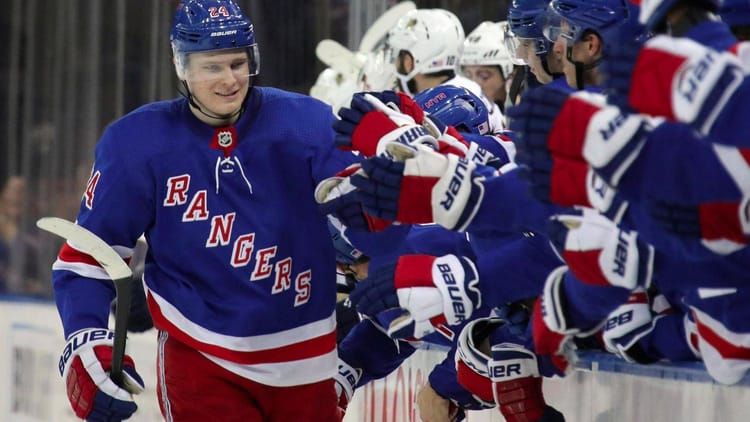
Heading into the season, a storyline to watch was how much of the Rangers ice time splits the kids were getting. The kid line, at least before some injuries, was slated to be kept together to start the season. But with Sammy Blais and Vitali Kravtsov out, Kaapo Kakko and Alexis Lafreniere were moved to the top six, while Filip Chytil stayed on the third line. The injuries are the bad news, but the good news is that through three games, the early Rangers ice time splits are favoring the kids.
Last season, this was a problem as Gerard Gallant buried the kids in an even line rotation, with the kids sometimes getting less ice time than some of the fourth liners. Now though, Kakko and Lafreniere are among the team leaders in the Rangers ice time split, at least at even strength. Chytil is up there as well.
Rangers ice time splits at even strength favor the kids
At even strength, Lafreniere is actually blowing everyone out of the water with over a minute of more even strength ice time than the rest of the team. His 15:03 TOI/G average is lapping Artemiy Panarin’s 13:48 and Vincent Trocheck’s 13:40. Kakko is next at 13:29, so the Rangers top two picks are tops on each of their respective lines thus far.
Filip Chytil is more or less tied with linemate Barclay Goodrow at 12:33 of ice time at even strength through three games.
Perhaps the biggest takeaway is that the fourth line, which last year was in an even rotation with the top nine, is only getting an average of 6-8 minutes a game at even strength. They will get more as the team gets healthy and the fourth line is a bit stronger, but for now, this is a promising sign that Gallant trusts his top nine and doesn’t feel the need to have his fourth line eat minutes.
As the season wears on, we will see some of this even out a bit, especially as the refs start swallowing whistles a bit.
All situations ice time leans on the best
It is no surprise that the Rangers ice time splits change a bit once you start adding special teams. PP1 still commands almost 4 minutes of time per game, compared to PP2’s 1 minute per game. That is not going to change, and with Trocheck sliding in as the bumper very effectively, that’s not likely to change. That’s also fine.
Shorthanded ice time is also indicative of leaning on the vets a bit more, at least early on. Zibanejad, Kreider, and Goodrow lead all Rangers there, to no surprise. As of now, and again to no surprise, only Lafreniere is getting any real PK time with 25 seconds a game. Basically one shift. Kakko gets 9 seconds a game, which seems low but that could change.
When you add all this together, the top four in the Rangers ice time splits are what you expect to see. But this year, Lafreniere is currently 5th with an average of 17:04 TOI/G. Kakko and Chytil are numbers 7 and 8 at 15:44 and 14:13, respectively. Both are capable of playing more, but without significantly more PP time, it’s simply not going to happen. Both would be fine on the PK, if the Rangers ever decide that Zibanejad and Kreider need a break.
All this will change
The Rangers ice time splits will continue to be a topic of conversation until there is a sense of comfort that the kids are getting more ice time consistently and when the Rangers are healthy. For good reason, there is always a sense of doom with kids, as the Rangers don’t have a good history of developing top-six forward talent. After several coaches that limited the ice time of key prospects, there’s some PTSD here, and it makes sense.
However this year looks different. This is the most balanced, skilled, and deepest team the Rangers have trotted out in the salary cap era (and longer). This year’s version of the Rangers is different. All the Rangers ice time splits will change, but it may not go the way you think it will.
Share:
More About:Analysis
